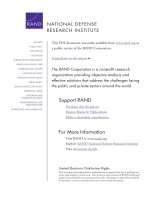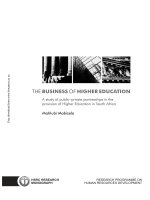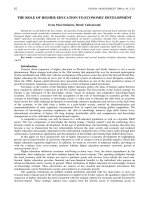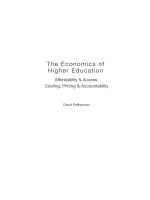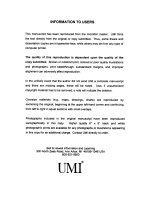An empirical analysis on the impact of higher education on income inequality
Bạn đang xem bản rút gọn của tài liệu. Xem và tải ngay bản đầy đủ của tài liệu tại đây (436.97 KB, 13 trang )
Journal of Applied Finance & Banking, vol. 10, no. 2, 2020, 179-191
ISSN: 1792-6580 (print version), 1792-6599(online)
Scientific Press International Limited
An Empirical Analysis on the Impact of Higher
Education on Income Inequality
Xinhua Hui1
Abstract
The study on the relationship between the higher education and income inequality
is of great importance to exploring ways to reduce income inequality. With the
macro-level time-series data of the United States from 1967 to 2015, this paper
empirically tested the relationship between higher education and income inequality.
The result indicated that there is a significant inverted-U relationship between
higher education and income inequality, that is, when the higher education is not
widely available, the bonus of higher education is significant, which can aggravate
income inequality. When the higher education is widely available, the education
expansion will narrow the income gap. At the same time, the model also verified
the impact of such variables as financialization, trade union density, trade
dependence, the proportion of female labor participation, and business cycle
fluctuations on the evolution of income inequality in the United States. Hopefully,
the result of this research can offer some helpful references for developing countries
to narrow their income gap by educational expansion.
Keywords: Higher education, income inequality, inverted-U relationship, macrolevel time-series data of the United States.
1
School of Social Science, Tsinghua University.
Article Info: Received: October 15, 2019. Revised: October 31, 2019.
Published online: March 1, 2020.
180
Xinhua Hui
1. Introduction
The development of education is the main driving force and influential factor for
sustained economic growth and improvement of productivity. It is also one of the
main ways for the middle and lower classes to enter the upper classes. Educational
investment is the most direct and major human capital investment, which will affect
economic growth and changes in the pattern of income distribution. Therefore,
educational expansion is one of the important factors affecting income distribution.
The educational attainment of American citizens is affected by many factors, among
which gender, race, place of birth(native or nonnative), physical condition
(disability or not) and family financial status are more influential ones. At present,
the difference in educational attainment between different genders has been almost
eliminated in the United States, but the income gap between genders still exists.
Race, as a relatively unique phenomenon in the United States, is related to historical
issues. Even though after long-term struggles and reforms, the educational
attainment of the people of all races in the United States is increasing, the
differences between races are still remarkable. The United States is a nation of
immigrants and therefore there are a large number of foreign-born citizens, and
native-born citizens are significantly better educated than foreign-born citizens.
Physical disability can also significantly affect educational attainment. Besides, the
family financial status and the educational attainment are negatively correlated.
Education has been making great contributions to the rapid development of the
United States, by cultivating a large number of talents. However, differences in the
educational attainment of citizens are also one of the main factors that widen the
gap in income distribution in the United States. Therefore, the study on the impact
of educational development in the United States on income inequality has always
been a hot topic in both the academic community and the society. This paper intends
to use the U.S. macro-level time-series data to verify the dynamic relationship
between higher education and income inequality in the United States, thus providing
a helpful supplement to relevant research.
2. Literature Review
The results of the existing literature on the impact of educational expansion on the
income gap can be roughly divided into four categories.
First, some scholars believe that educational expansion may widen the gap in
income distribution. For example, Bhagwati (1973) believed that the educational
expansion will increase the income gap, since it will allow the low-income groups
with higher educational attainment to get better-paid jobs than those with lower
educational attainment, especially in the countries with low economic development
levels. Sylwester (2000) pointed out that higher education means higher income in
the future, so the cost is higher. Therefore, opportunities for higher education are
more likely to be obtained by people with higher income, while the poor can’t afford
higher education and thus can’t get out of the poverty trap. The Matthew Effect can
make the income gap wider and wider.
An Empirical Analysis on the Impact of Higher Education on Income Inequality
181
Second, some others think just the opposite: they argue that educational expansion
will narrow the gap in income distribution. Ahluwalia (1976) pointed out that,
according to the Human Capital Theory, in the case of increased supply of skilled
labor and high marginal productivity of labor, it is possible to improve the
productivity of low-income population by providing more education opportunities
for them and improving their educational level, and, consequently, increase the
income of low-income population, bridging their income gap with high-income
population. Psacharopoulos (1982) believed that with the continuous improvement
of the educational level of the female, women can may get better-paid jobs, which
will be able to narrow the income gap caused by gender.
Third, some scholars believe that the impact of educational expansion on income
distribution is uncertain. Mincer (1974) pointed out whether increasing the average
years of schooling for citizens can narrow the income gap or not depends on changes
in the rate of return to education: the result may be positive or negative. Alesina and
Perotti (1996) pointed out that whether the educational expansion will reduce the
income inequality or not depends on the relationship between the cost of education
and the value of per capita income. When the cost of education exceeds the per
capita income, the rich can afford higher education, while the poor can’t. So the
stock of human capital of the rich increases and their future income also increases,
thus widening the income gap between the rich and the poor. However, when the
education cost is lower than the per capita income, the poor can afford the education
expenses like the rich, so that the income gap with the rich can be reduced. Gregorio
and Lee(2002) pointed out that the inequality in education will worsen the
inequality in income, but the effect of improving education on income distribution
is uncertain in the case that the education distribution remains unchanged.
Last, some scholars believe that the relationship between the educational expansion
and the income distribution gap is in line with the inverted-U curve: in the early
stage of education expansion, the gap in income distribution tend to increase, while
after reaching a certain inflection point, the income gap began to narrow with
educational expansion. The inverted-U relationship between education and income
inequality was first proposed by Londono (1990) and Ram(1990). Basing on crosssectional data from more than 90 countries, Ram empirically showed that the
inflection point of the inverted-U curve was about 7 years of schooling on average.
Thomas (2002) et al. extended the data to 140 countries for empirical analysis and
verified Ram’s conclusion of “7-year inflection”.
In addition, other views exist that public and private educations should be
researched separately. For example, Eckstein and Zilcha (1991) proposed that the
lower limit of fund provided by the government should be set to support compulsory
education, which can help to narrow the income gap. Dablanorris et al.(2004)
believed that increasing the budget for public education requires the government to
be the strong backup force to reduce the income distribution gap. The model
analysis of Fernandez and Rogerson (1995) showed that the public education
expenditure affects the opportunities for the poor to receive education.
182
Xinhua Hui
3. Model Specification and Data Presentations
With the macro time series data of the United States from 1967 to 2015, this paper
empirically tested the non-linear relationship between the higher education and
income inequality in the United States. This paper collected a relatively
comprehensive data on control variables affecting the income inequality from
multiple databases, which can better separate and verify the impact of factors other
than education on income distribution.
3.1
Model Specification
Based on the existing literature, the following regression model is established:
ineq = 0 + 1edu + 2edu 2 + 3control +
The explained variable “ineq” is the Gini coefficient, which represents income
inequality, and the explanatory variable “edu” represents the higher educational
attainment in the United States. “Control” represents other control variables that
have an impact on income inequality other than educational factors; if 2 is
significant, it confirms the non-linear relationship between the higher education
level and income inequality in the United States. In particular when 1 0, 2 0 ,
it shows that there is an inverted-U relationship between the higher educational
attainment and income inequality in the United States.
3.2
Variable Selection Description and Data Sources
The explained variable “Gini” represents the degree of income inequality. Gini
coefficient was used to measure in this paper and the Data comes from the Current
Population Survey published on website of the United States Census Bureau.
The explanatory variable “edu.” refers to the proportion of people aged 25 and over
who have a university degree or above. Data Sources: the website of United States
Census Bureau.
Control variables refers to other factors that have an impact on income inequality in
the US economic development. The following 7 variables are selected in this paper.
The natural logarithm of gross domestic product per capita is “LnGDPpercapita”.
Gross domestic product per capita was selected as an indicator of economic growth
to control the impact of economic growth on income inequality, while eliminating
heteroscedasticity by taking natural logarithms. Data sources: the website of the
World Bank .
Business Cycle is referred to as “inverseu”. This paper uses the reciprocal of
unemployment rate lagging two periods1/ U t −2 . Higher unemployment and a more
severe economic recession might lead to an increase in income inequality, which is
the comprehensive result of the direct impact of loss of income due to
unemployment and the indirect impact of falling income due to the economic
An Empirical Analysis on the Impact of Higher Education on Income Inequality
183
recession. However, this effect was not caused by labor income alone. The
economic downturn would also reduce capital utilization and reduce capital income.
Therefore, it is impossible to directly judge the final change in income inequality.
In the early stages of the cyclical recovery after the economic recession, income
inequality will increase due to the coexistence of rapid recovery of profits and the
stagnation of wages. The reciprocal of the unemployment rate is generally used to
measure the role of the business cycle, and empirical experience indicates that the
unemployment rate in the two periods better showed the deviation of profit and
labor income after the economic recession. The data on unemployment rate comes
from the website of the U.S. Bureau of Labor Statistics.
Trade Union Density is referred to as “Union”: “Union” = the number of union
members (non-agricultural) / total number of workers. Trade union organizations in
the United States play a pivotal role in wage negotiations. The greater the density
of trade unions, the stronger the bargaining power of workers and the more
favorable to the increase in workers’ income. Therefore, there is a positive
correlation between trade union density and workers’ labor income. Beginning in
the late 1960s, the density of trade unions in the United States began to decrease
severely. This phenomenon particularly affected industries dominated by collective
bargaining negotiations (Fichtenbaum’s (2011), resulting in the decrease of the
workers’ wages, and thus increasing income inequality. The Data comes from the
website of trade union membership and coverage database.
Foreign trade dependence is referred to as “trade”. “Trade”= total net export/GDP.
The Stolper-Samuelson Theorem states that international trade affects the relative
price of factors, increases the price of sufficient factors in the country, and lowers
the price of scarce factors in the country. The United States has relatively abundant
technological and capital factors. International trade will increase the income of
elites with more capital and highly skilled workers, while decreasing the income of
unskilled workers. Therefore, international trade will increase income inequality.
Data comes from the the website of Bureau of Economic Analysis of the United
States.
Import share is referred to as “importshare”. “importshare” = total import / GDP. In
the 1970s, the United States is transformed from a net exporter to a net importer.
Many export industries with higher wage levels saw a decline in its business, while
low-cost imports increase the competition between cheap foreign labor and
domestic labor, resulting in lower wages for American workers. Therefore, the
import share will increase income inequality. Although the import share and foreign
trade dependence affects the income inequality differently, there might be strong
collinearity between the two. Therefore, in the regression analysis, these two
variables can be used for verification respectively. Data comes from the website of
Bureau of Economic Analysis of the United States.
The proportion of female labor participation is referred to as “femaleLF”. In the
1960s and 1970s, the proportion of female labor participation increased
significantly in the United States, but then the income inequality increased
significantly in the 1980s. Therefore, there may be certain relationship between the
184
Xinhua Hui
proportion of female labor participation and income inequality. One of the main
reasons may be that the increase in the female labor participation results mainly
from families with higher income. Therefore, the increase in female labor
participation will further increase the income of families with high income, which
will in turn increase income inequality. The data is from the website of US Bureau
of Labor Statistics.Financialization is referred to as as “fir”. It mainly reflects the
improvement of capital allocation efficiency in capital market by financial
development, but unfortunately, the official measurement indicators failed to be
found. Therefore, based on the research results of the existing literature, this paper
defines two definitions of “fir”: I. Financial related ratio, i.e. “fir1” = Financial
related total assets (finance, insurance, real estate, leasing, etc.)/GDP, and the data
comes from the website of US Federal Reserve System; II. Output value ratio of
financial related industry, i.e. “fir2” = total output value of financial related industry
(finance, insurance, real estate, leasing, etc./total output value of all industries. The
data comes from the website of US Federal Reserve System.
The statistical characteristics of each variable are shown in Table 1.
Table 1: Statistical Characteristics of Major Variables
Names
of
Variables
Abbreviation
Number
of
Variables
Mean
Value
Standard
Deviation
(SD)
Median
Value
Minimum
Value
Maximum
Value
Gini Coefficient
GINI
49
43.55
3.09
43.1
38.8
48.2
Financialization 1
FIR1
69
0.16
0.03
0.16
0.1
0.2
Financialization 2
FIR2
69
0.13
0.03
0.11
0.08
0.18
Educational Level
EDU
58
19.33
7.84
19.65
5.4
32.5
Foreign Trade
Dependence
Trade Union
Density
The proportion of
Female Labor
Participation
TRADE
56
-0.02
0.02
-0.01
-0.05
0.01
NONMEM
42
12.49
5.57
10.65
6.6
24.6
FEMALE
41
0.53
0.04
0.54
0.42
0.58
Business Cycle
INVERSEU
67
0.19
0.05
0.18
0.1
0.34
Natural
Logarithm of Per
Capita GDP
LNGDP
56
9.71
0.94
9.94
8.01
10.93
Import
IMPORT
24
0.14
0.02
0.14
0.10
0.17
An Empirical Analysis on the Impact of Higher Education on Income Inequality
185
Based on the above variables, the following multivariate regression model can be
established.
Ineq = 0 + 1edu + 2edu ^ 2 + 3 LnGDPpercapita + 4 (1/ U t −2 )
+ 5Union + 6trade + 7 femaleLF + 8 fir +
4. Results of Empirical Analysis
4.1
Multicollinearity Test
The Variance Inflation Factor method (VIF) was used to perform a multicollinearity
test on the explanatory variables, and the test showed that there was a significant
multicollinearity between “trade” and “LnGDPpercapita”, a result which was
similar to some of the previous literature studies. Because “trade” contains the
influence of “LnGDPpercapita”, LnGDPpercapita was removed in the regression.
4.2
Unit Root Test
Macro-level time-series data have obvious time trend, possibly causing false
regression results, so the stationarity of the data should be checked before regression.
ADF test showed that the explained variables, explanatory variables, and most of
the control variables (except for “union” and “inverseu”) had unit roots, which
were non-stationary time series. The ADF test showed that the series after the
difference was stationary, indicating that the original series is I(1). The test results
are shown in Table 2.
186
Xinhua Hui
Table 2: Unit Root Test for Related Variables (DF Test)
Original Series
Series after
First Order
Difference
Critical Value
Significant
level at 5%
Stationarity
Indicator
Variable
DF
Statistics
Inequality
Gini
-0.204
-0.292
Non-stationary
Financialization
fir1
-1.482
-2.905
Non-stationary
fir1^2
-0.823
-2.905
Non-stationary
Union
-3.607
-2.937
Stationary
Trade
-1.454
-2.916
Non-stationary
femaleLF
-2.555
-2.939
Non-stationary
edu
0.011
-2.920
Non-stationary
Inverseu
-3.598
-2.907
Stationary
Inequality
DGini
-6.561
-2.927
Stationary
Financialization
Dfir1
-9.068
-2.906
Stationary
Dfir1^2
-9.386
-2.906
Stationary
DUnion
-5.511
-2.941
Stationary
DTrade
-6.423
-2.917
Stationary
DfemaleLF
-2.935
-2.939
Stationary
Dedu
-6.324
-2.921
Stationary
DInverseu
-7.605
-2.907
Stationary
Control Variable
Control Variable
In order to prevent the inaccuracy of the results brought by the single test method,
the paper also used the PP test to test the stationarity of the data. The test results are
consistent with the DF test, and will not be repeated here.
4.3
Co-integration Test
Since the original series was a non-stationary time series, the co-integration
relationship between the variables should be tested. The results of Johansen test are
shown in Table 3 below. The results are significant at 5%, the null hypothesis that
“co-integration rank is 0” can be rejected, that is, there does exist a co-integration
relationship.
An Empirical Analysis on the Impact of Higher Education on Income Inequality
187
Table 3: Co-integration Test Results
Trend: trend
Sample:1978-2015
Hypothesized
No. of CE(s)
None *
At most 1 *
At most 2 *
At most 3 *
At most 4 *
At most 5 *
At most 6 *
At most 7 *
Johansen tests
Eigenvalue
1.00
0.88
0.83
0.79
0.64
0.53
0.41
0.00
Hypothesized
No. of CE(s)
Eigenvalue
None *
At most 1 *
At most 2 *
At most 3 *
At most 4 *
At most 5 *
At most 6 *
At most 7 *
1.00
0.88
0.83
0.79
0.64
0.53
0.41
0.00
Trace Statistic
498.19
263.42
192.38
132.47
78.78
43.70
18.06
0.03
Max-eigen Statistic
234.77
71.04
59.92
53.69
35.08
25.65
18.03
0.03
Number of obs=34
Lags=2
5% Critical
Value
159.53
125.62
95.75
69.82
47.86
29.80
15.49
3.84
Prob.**
0.00
0.00
0.00
0.00
0.00
0.00
0.02
0.86
5% Critical
Value
Prob.**
52.36
46.23
40.08
33.88
27.58
21.13
14.26
3.84
0.00
0.00
0.00
0.00
0.00
0.01
0.01
0.86
Because of the co-integration relationship between variables, co-integration
regression was used to test the long-term relationship between income inequality
and educational level. This paper didn’t use the first-order difference series of each
variable for regression, because the use of the difference model can ensure the
stationarity of the data, the economic significance of the regression model is very
different.
4.4
Regression Analysis
The results of the co-integration regression are shown in Table 4, and the results
showed that the variables had a long-term equilibrium relationship. In the regression
analysis, the model containing only the explanatory variables was firstly regressed,
and then the influence of the control variables on the explained variables was tested
by adding control variables step by step
188
Xinhua Hui
Table 4: Co-integration Regression Results
Indicator
Educational
Level
Control
Variable
Sample Size
R2
Explanatory
Variable
edu
edu^2
Model 1
0.036***
-0.001***
Fir
Union Trade
Female
LF Inverseu
49
0.258
Explained Variable Gini
Model 2
Model 3
0.014***
0.014***
-2.00E-04** -1.78E-04***
0.970***
0.576
0.004***
0.003***
0.318***
0.136***
40
0.933
38
0.940
Model 4
0.005***
-8.85E-06*
0.874***
0.003***
0.295***
0.294***
-0.073***
38
0.949
Note: *, **, *** indicate significance at significant levels of 10%, 5%, and 1% respectively.
The regression results of model 1 showed that the primary regression coefficient of
the variable “edu” was positive, and the quadratic regression coefficient was
negative, and both were significant at the 1% significance level, indicating that there
was a significant inverted-U relationship between income inequality and
educational attainment. That is to say, in the early stage of education expansion, the
income distribution gap was widened, while after reaching a certain inflection point,
the income gap began to narrow with the education expansion. The empirical results
were consistent with the actual economic situation. At the lower level of education,
the smaller groups receiving higher education can obtain better-paid jobs in the
employment market. Because of the low mobility between different types of work,
the bonus of higher education is significant, which can increase income inequality.
At a higher level of education, however, a large proportion of people have access to
higher education, so the participants in the highly competitive job market were
roughly equal in their ability. Therefore, the bonus of higher education was no
longer remarkable, and the education expansion narrowed the income gap in this
stage.
The control variables “fir” and “Union” were added to the model 2. The regression
results showed that the effect of “edu” stay the same after adding the control
variables: they only reduced the coefficient to some extent. The impact of
financialization and trade union density on income inequality was positive, and
consistent with the relevant literature conclusions.
The control variables “femaleLF” and “inverseU” were added to the model 2. The
regression results showed that the effect of “edu” stay the same after adding the
control variables: they only reduced the coefficient to some extent. Among them,
the regression coefficient of trade was significantly positive, indicating that the
development of international trade can increase income inequality. International
trade has increased the price of the relatively abundant capital and technology in the
United States, which increased the income of high-income population who had the
advantages in these two factors, thus increasing income inequality. “Trade” was
An Empirical Analysis on the Impact of Higher Education on Income Inequality
189
replaced by the variable “importshare” for regression, and the sign and significance
of the regression coefficients remained basically unchanged. The coefficient of
variable “femaleLF” was significantly positive. With the development of economy,
more American women entered the labor market, which happened more in highincome families, so the proportion of female labor participation will increase
income inequality. The regression coefficient of “inverseU” was significantly
negative, indicating that the income inequality would decline with the business
cycle fluctuations, mainly because in the economic depression, both the labor
income and the capital income would decline due to the decrease of capital
utilization.
The regression coefficient indicated that the control variables did exert an impact
on income inequality. In terms of coefficient, “trade” and “femaleLF” had a greater
effect on income inequality than “edu” and trade union density.
4.5
Error Correction Model and Its Test
Co-integration regression results showed long-term equilibrium relationship among
income inequality, explanatory variables and control variables (inverted-U
relationship). In order to test the short-term equilibrium relationship between
variables, an error correction model should be used.
The regression results of the error correction model showed an adjustment factor of
0.053, which was significant at the 10% significance level. That is to say, when the
short-term effects of the education level, financialization, and trade union density
on income inequality deviate from their long-term equilibrium, they will return to
the long-term equilibrium state with an adjustment of 0.053.
Figure 1: VECM System Stability Determination
190
Xinhua Hui
The reliability of the regression model was verified by the VECM system stability
test. The results are shown in Figure 1. Not only the hypothetical unit root of the
model was inside the unit circle, but all the eigenvalues of the adjoint matrix fell
within the unit circle, indicating that the system was stable.
5. Conclusion
The development and reform of higher education play an important role in
economic growth, income distribution and social stability. Therefore, the analysis
of their influence modes and relations has important theoretical and practical
significance. With the macro time series data of the United States from 1967 to 2015,
this paper tested the relationship between income inequality and the higher
education, showing that there is a significant inverted “U” model relationship
between the two. That is to say, when the higher education is not widely available,
the bonus of higher education is tremendous, which can increase income inequality.
When the higher education is widely available, a large proportion of people can
have access to higher education, the participants in the highly competitive job
market are roughly equal in their ability. Therefore, the education expansion will
narrow the income gap in this stage. This conclusion is helpful for developing
countries. Higher education reform is a focus issue in the development of
developing countries. The income inequality of residents can be narrowed by having
more people receive higher education.
Moreover, this paper also verified the positive impact of variables such as
financialization, trade union density, trade dependence and the proportion of female
labor participation, and negative impact of business cycle fluctuations on the
evolution of income inequality in the United States. There is still room for further
analysis of the relationship between education inequality and income inequality in
the future.
References
[1] A. Alesina and R. Perotti, Income Distribution, Political Instability, and
Investment, European economic review, 40(6), (1996), 1203-1228.
[2] E. Dablanorris and M. Gradstein, The Distributional Bias of Public Education:
Causes and Consequences, International Monetary Fund, 2004.
[3] G. Psacharopoulos, Earnings and education in Greece,1960–1977, European
Economic Review, 17(3), (1982), 333 - 347.
[4] J. A. Mincer, Schooling and Earnings, NBER Chapters, (1974), 41- 63.
[5] J. D. Gregorio and J. W. Lee, Education and Income Inequality: New Evidence
From Cross-Country Data, Review of Income and Wealth, 48(3), (2002), 395
- 416.
[6] J.N.Bhagwati, Education, Class Structure, and Income Equality, World
Development, 1(5), (1973), 21 - 36.
[7] K. Sylwester, Income Inequality, Education Expenditures, and Growth,
Journal of Development Economics, 63(2), (2000), 379 - 398.
An Empirical Analysis on the Impact of Higher Education on Income Inequality
191
[8] M. S. Ahluwalia, Inequality, Poverty and Development, Journal of
Development Economics, 3(4), (1976), 307 - 342.
[9] R. Fernandez and R. Rogerson, On the Political Economy of Education
Subsidies. Review of Economic Studies, 62(2), 1995, 249 - 262.
[10] R. Ram, Educational Expansion and Schooling Inequality: International
Evidence and Some Implications, Review of Economics & Statistics, 72(2),
1990, 266 - 274.
[11] V. Thomas, W. Yan and X. Fan, A New Dataset on Inequality in Education:
Gini and Theil Indices of Schooling for 140 Countries 1960-2000, World Bank,
2002.
[12] Z.Eckstein and I. Zilcha, The Effects of Compulsory Schooling On Growth,
Income Distribution and Welfare. Economic Quarterly, 40(2)1993, 243 - 251.
